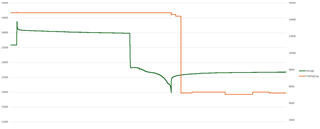Other Parts Discussed in Thread: BQ34Z100, GPCCHEM, BQSTUDIO, EV2400
We're using a LiFePO4 battery and are using the BQ34Z100 on a separate pcb to monitor just the voltage, current and state of charge/capacity. We've managed to complete the learning cycle and are running some tests to verify the gauge's behaviour.
In this particular test the battery was charged to full, allowed to relax for about 20 hours, discharged, and left to relax.
Do you know what could cause the Full Charge Capacity to radically drop when the battery is relaxing at a low voltage?

I've attached the full recorded log.

